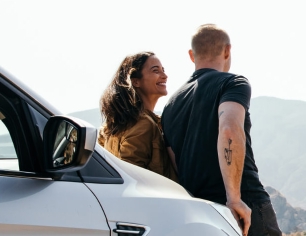How to avoid hitting a deer
More than one million car accidents involve deer each year, resulting in $1 billion in damage. Fortunately, there are things you can do to reduce your chances of hitting a deer when you're behind the wheel. Understanding when and where they're most likely to show up can help you avoid having a run-in with one.
Explore Progressive Answers' auto editorial guidelines to find out why you can trust the car insurance information you find here.
Know where and when deer are most active
You may be more likely to encounter a deer if you live in a rural area, but they're a risk even if you're driving in the suburbs or on the highway. Understanding when you're most likely to see deer on the road can help keep you — and them — safe.
Deer are most active at dawn, dusk, and for a few hours after the sun sets. They're also more prevalent during mating season, which runs from October to January. Animal strike claims are more than twice as likely in November than any other time of the year.
How to avoid deer at night
Because deer tend to be active after sunset, it's imperative to stay alert if you're driving at night. Here are a few tips to help you spot deer on the road and avoid an accident.
- Upgrade your headlights. Choose LED or HID bulbs instead of traditional halogen. Both produce a brighter light that makes it easier to spot animals in the distance.
- Be wary of the woods. If you're driving on a road that's wooded on one or both sides, deer could be lurking just out of sight, waiting to make a run for it.
- Slow down. Deer don't usually travel alone. If you spot one, chances are, there are more nearby. Slow down and watch out for the rest of them.
- Look for glowing eyes. Deer have yellow eyes that look like they glow in the dark. If you catch a glimpse of yellow, assume it's a deer and slow down.
- Pay attention to road signs. If you see a deer crossing sign on the road, it means you're in an area with a large deer population.
- Use your high beams. If you're driving in a low-light area with few or no streetlamps, turn on your high beams for greater visibility. Just be sure to turn them off if you see another car coming.
- Look out for recently killed deer. Deer typically travel in groups. If you see a deer on the side of the road that was hit recently, others could be nearby.
What to do if a deer runs in front of your car
If you spot a deer, blow your horn to get their attention and scare them away. Don't count on deer whistles or other gadgets to send them running.
Take steps to protect yourself
Even the most careful drivers can't protect themselves from every unexpected event that might happen on the road. Here are some things you can do to help you stay safe if you have a run-in with a deer — or any other animal.
- Wear your seat belt. Many states have seat belt laws for a good reason. They can help protect you if you're in an accident, whether with a deer or another vehicle.
- Stay in your lane. If you see a deer coming, your instinct might be to swerve out of the way. If you do, you could end up in oncoming traffic. Instead, stay in your lane and apply the brakes evenly until you stop.
What to do if you hit a deer
If despite your best efforts, you hit a deer, there are a few things you should do.
Pull over if you can. Make sure you and everyone in your vehicle are safe. Get medical attention if you need it.
Don't touch the deer. They will be disoriented and could hurt you. Instead, call the police.
Check your auto policy. If you carry comprehensive coverage, you may be covered for damage to your vehicle, minus your deductible. In 2018, the average cost of an animal strike claim was $3,875. Read more on insurance coverage for deer accidents.
Make sure you have the right coverage for your car with Progressive
Current Progressive customers
You can log in or call 1-866-749-7436 to check on your coverages.
New Progressive customers
Quote auto insurance online or call 1-866-749-7436 to insure your car.

Quote car insurance online or give us a call
Learn more about car insurance policies.









